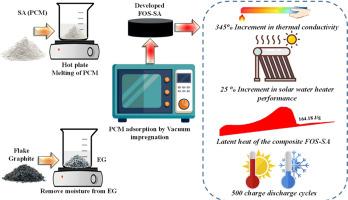Enhancing charging/discharging performance of solar-assisted water heater integrated with stearic acid/expanded graphite as form-stable phase change material
IF 6.3
3区 工程技术
Q1 ENGINEERING, CHEMICAL
Journal of the Taiwan Institute of Chemical Engineers
Pub Date : 2025-09-18
DOI:10.1016/j.jtice.2025.106406
引用次数: 0
Abstract
Background
Stearic acid (SA) among organic phase change materials (PCMs) is in high demand due to its high latent heat, suitable melting temperature range, chemical stability, non-toxicity, and cost-effectiveness. However, the practical application of SA, similar to organic PCMs, is hindered due to low thermal conductivity and leakage during phase transitions. These shortcomings reduce heat transfer efficiency, increase system complexity, and cost.
Methods
The present research aims to develop a form-stable stearic acid (FOS-SA) composite as a heat storage material. The composite was characterized for thermal conductivity, FTIR, TGA, and DSC before and after 500 thermal cycling treatments to reveal its stable chemical/thermal properties and their long-term utilization. Furthermore, for its practical utilization, the developed composite was then integrated into a packed bed solar water heater (PBD-SWH), and its thermal performance was compared against pure SA at flow rates of 12, 16, and 20 L/h.
Significant Findings
The composite was characterized for thermal conductivity, demonstrating a 345 % enhancement. FTIR confirmed physical interaction between SA and expanded graphite (EG) without chemical alteration, and TGA validated strong thermal stability, whereas DSC revealed its stable thermal characteristics. The developed composite also exhibits favourable results when it has undergone 500 thermal cycling treatments, confirming its reliability for long-term utilization. The results revealed that FOS-SA reduced charging and discharging times by 11–17 % and 17–26 % respectively, and indicated that 20 L/h is the most effective in enhancing the thermal performance of PB-SWH. This research demonstrates, for the first time, the effective integration of FOS-SA into a PB-SWH. The findings establish FOS-SA as a viable and high-performance candidate, not only addressing leakage and low thermal conductivity issues but also substantially improving the system's thermal performance.

硬脂酸/膨胀石墨复合相变材料增强太阳能辅助热水器充放电性能
硬脂酸(硬脂酸)因其具有较高的潜热、适宜的熔融温度范围、化学稳定性、无毒性和成本效益等优点,在有机相变材料(PCMs)中受到广泛的应用。然而,与有机PCMs类似,SA的实际应用受到相变时导热系数低和泄漏的阻碍。这些缺点降低了传热效率,增加了系统的复杂性和成本。方法制备一种形式稳定的硬脂酸(FOS-SA)复合材料作为储热材料。通过500次热循环处理前后的热导率、FTIR、TGA和DSC表征,揭示了复合材料稳定的化学/热性能及其长期利用价值。此外,为了实际应用,将所开发的复合材料集成到填充床太阳能热水器(PBD-SWH)中,并将其与纯SA在流量为12、16和20 L/h时的热性能进行了比较。重要发现:该复合材料的导热性能增强了345%。红外光谱(FTIR)证实了SA与膨胀石墨(EG)之间的物理相互作用,没有发生化学变化;热重分析证实了SA具有较强的热稳定性,而DSC则显示了其稳定的热特性。经过500次热循环处理后,所开发的复合材料也显示出良好的效果,证实了其长期使用的可靠性。结果表明,FOS-SA分别减少了11 - 17%和17 - 26%的充放电次数,并表明20 L/h对PB-SWH热性能的提高最为有效。本研究首次证明了FOS-SA与PB-SWH的有效集成。研究结果表明,FOS-SA是一种可行的高性能候选材料,不仅可以解决泄漏和低导热性问题,还可以大大提高系统的热性能。
本文章由计算机程序翻译,如有差异,请以英文原文为准。
求助全文
约1分钟内获得全文
求助全文
来源期刊
CiteScore
9.10
自引率
14.00%
发文量
362
审稿时长
35 days
期刊介绍:
Journal of the Taiwan Institute of Chemical Engineers (formerly known as Journal of the Chinese Institute of Chemical Engineers) publishes original works, from fundamental principles to practical applications, in the broad field of chemical engineering with special focus on three aspects: Chemical and Biomolecular Science and Technology, Energy and Environmental Science and Technology, and Materials Science and Technology. Authors should choose for their manuscript an appropriate aspect section and a few related classifications when submitting to the journal online.

 求助内容:
求助内容: 应助结果提醒方式:
应助结果提醒方式:


